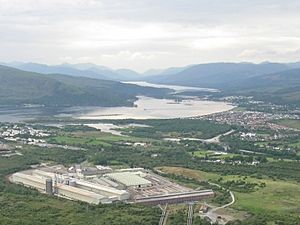Battle of Inverlochy (1431) facts for kids
Quick facts for kids Battle of Inverlochy (1431) |
|||||||
|---|---|---|---|---|---|---|---|
| Part of the Scottish clan wars | |||||||
 Battlefield is the green field above the squareish central building of the aluminium factory |
|||||||
|
|||||||
| Belligerents | |||||||
| Lordship of the Isles | Scottish Crown | ||||||
| Commanders and leaders | |||||||
| Donald Balloch Alasdair Carrach. |
Alexander Stewart, Earl of Mar Allan Stewart, 4th Earl of Caithness |
||||||
| Strength | |||||||
| Unknown | Unknown | ||||||
| Casualties and losses | |||||||
| 30 | 900 | ||||||
| Official name | Battle of Inverlochy I | ||||||
| Designated | 14 December 2012 | ||||||
| Reference no. | BTL34 | ||||||
The Battle of Inverlochy (1431) (Scottish Gaelic: Blàr Inbhir Lòchaidh) was an important fight in Scottish history. It happened near what is now Fort William, Scotland. This battle was part of the ongoing conflicts between the powerful Lordship of the Isles and the Scottish Crown.
The fight began after Alexander of Islay, who was the Lord of the Isles and the Earl of Ross, was put in prison by King James I. Alexander was a very important leader in the Highlands. His cousin, Donald Balloch, led a group of Highland warriors to challenge the King's forces.
Contents
What Happened at the Battle of Inverlochy?
The Clash of Forces
In September 1431, Donald Balloch's Highland army met the King's forces. The King's army was led by two important noblemen: the Earl of Mar and the Earl of Caithness. The battle took place at Inverlochy.
The Highland warriors fought bravely. They managed to defeat the Royalist forces, which were the King's soldiers. This was a big victory for the Lordship of the Isles.
Battle Results and Casualties
Many people were killed in the battle. It is believed that over 1,000 men lost their lives. Among those killed was the Earl of Caithness, a key leader for the King. The Lordship of the Isles suffered about 30 casualties, while the Scottish Crown's forces had around 900 casualties.
After winning the battle, Donald Balloch continued to attack the lands of Clan Cameron and Clan Chattan. These clans had not supported Alexander when he was imprisoned. Soon after, King James I himself led a large army into the Highlands. This made the Highland forces stop their attacks.
After the Battle: Alexander's Release
A Royal Amnesty
In October 1431, King James I decided to release Alexander of Islay from prison. This happened as part of a special royal pardon. The pardon was given to several people when the King's son, James II, was born.
Alexander was once again recognized as the Earl of Ross. This meant he was seen as the main leader who could bring peace and order to the Highlands. He gained control of important towns like Dingwall and Inverness. He held control of Inverness until at least 1447.
Alexander's Growing Power
By January 1437, Alexander was officially using the title "Earl of Ross" in his documents. The King's government also recognized this title by 1439. This showed how much power Alexander had gained.
In February 1439, Alexander received an even more important role. He was made the Justiciar of Scotia. This job made him the chief legal officer in the entire Kingdom of Scotland. It was a very powerful position.
Music and Memory
Traditional Battle Tunes
The battle is remembered in traditional Scottish music. A type of bagpipe music called a pibroch is linked to the event. The pibroch The End of the Great Bridge is said to have been composed during the battle itself.
Another pibroch, Piobaireachd Domhnull Dubh, also remembers the battle. This tune is named after Donald Dubh Cameron, a clan chief. These musical pieces help keep the story of the Battle of Inverlochy alive.
See also

